How to Grow Longan Tree
- April 3, 2024
- 1 comment
Longan, scientifically known as Dimocarpus longan, is a tropical tree famous for its sweet and aromatic fruit. Native to Southeast Asia, longan is a close relative of the lychee. Its cultivation has spread to warm climates around the world. Growing a longan tree can be a rewarding experience for a gardener due to its lush foliage and sweet fruits. This article will guide you through the process of growing a longan tree, from planting to harvest.

List on How To Grow Longan Tree
Choosing a Site
Climate and Soil Requirements
Longan trees are well-suited to tropical climates, exhibiting a resilience that allows them to withstand cooler temperatures better than lychees. Here’s what to consider in terms of climate and soil:
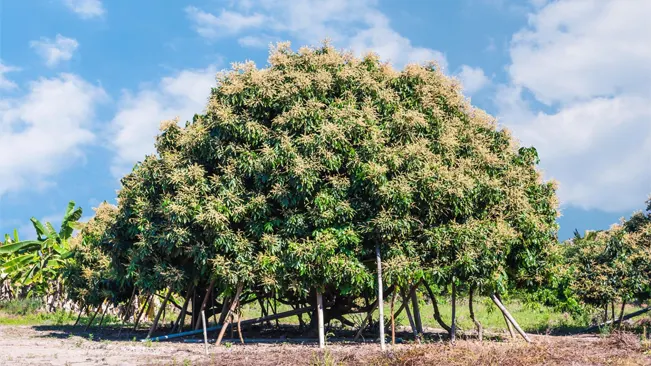
- Climate Adaptability
- Temperature Range: While predominantly tropical, longan trees can tolerate cooler temperatures to a certain extent but are sensitive to frost. In regions with mild winters, they can survive and produce fruit.
- Rainfall and Humidity: Longans prefer a humid climate with regular rainfall, but they also need a distinct dry period for proper flowering and fruiting.
- Soil Preferences
- Texture: The ideal soil texture for longan trees is sandy loam or loamy sand. These types offer excellent drainage, which is crucial for preventing root rot and other water-related issues.
- pH Level: A slightly acidic to neutral pH range (about 6.0 to 7.5) is optimal. This pH range allows the tree to absorb nutrients efficiently.
- Site Selection
- Avoid Flood-Prone Areas: It’s important to avoid planting in areas prone to flooding or where water tends to accumulate. Excessive moisture can be detrimental to the tree’s root system.
- Consider Elevation: In regions with varying elevations, lower areas might be more prone to cold air pools and frost. Higher, well-drained areas are often more suitable.
Sunlight
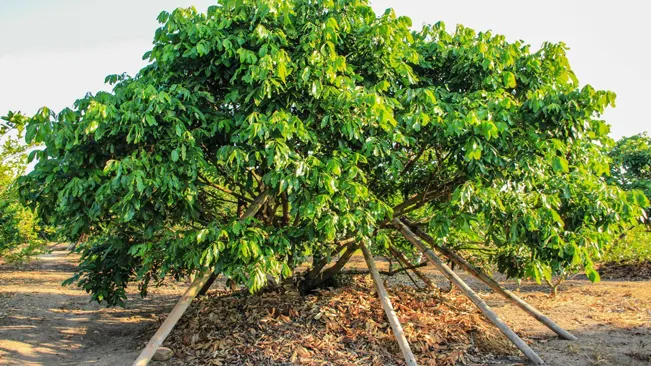
- Amount of Sunlight
- Longan trees require full sunlight, which means they should receive at least six hours of direct sunlight per day.
- This requirement is essential for the tree’s photosynthesis process, overall health, and fruit production.
- Positioning the Tree
- When choosing a planting spot, ensure it’s in an area that isn’t overshadowed by taller structures or trees, especially during critical growth periods.
- In regions with intense afternoon sun, some light afternoon shade might be beneficial, particularly for young trees.
- Maximizing Sun Exposure
- Orient the planting in a way that maximizes sun exposure to all parts of the tree. This can involve strategic placement and considering the angle of sunlight at different times of the year.
Planting
Planting Grafted Longan Saplings
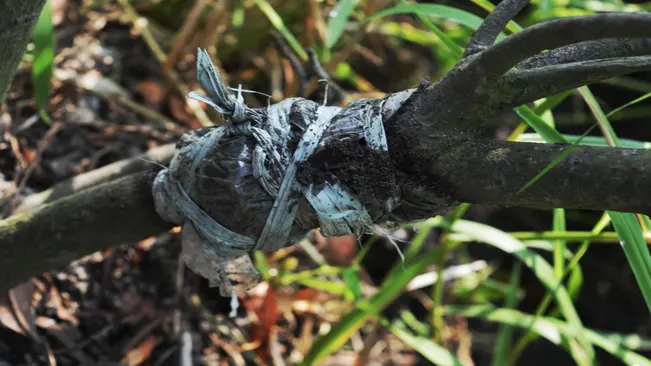
Why Choose Grafted Saplings?
- Faster Fruit Production: Grafted saplings are known to bear fruit sooner, often within 3-4 years, compared to seed-grown trees which might take 5-7 years or more.
- Quality Assurance: Grafting ensures the sapling inherits the fruit quality and characteristics of the parent tree, leading to more predictable and reliable fruit production.
- Disease Resistance: Often, grafted saplings are selected for their resistance to certain soil-borne diseases and pests.
The Planting Process in Detail
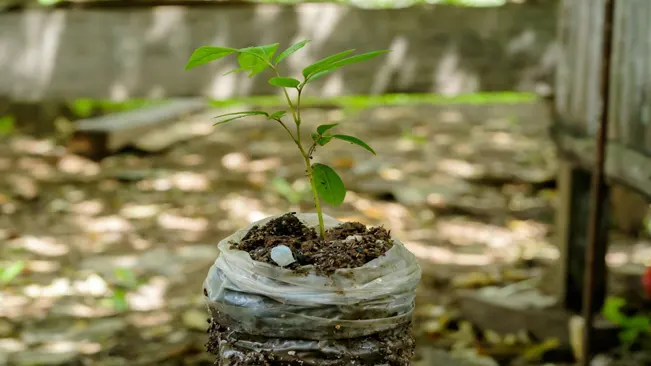
- Choosing the Right Sapling
- Select healthy grafted longan saplings from a reputable nursery.
- Look for saplings with vigorous growth and no signs of disease or stress.
- Preparation
- Choose a planting location with full sun exposure and well-draining soil.
- Dig a hole about twice the width and the same depth as the root ball of the sapling to ensure enough space for the roots to spread.
- If the soil is poor, consider amending it with organic compost to improve fertility and drainage.
- Planting
- Carefully remove the sapling from its container, trying not to disturb the root ball excessively.
- If roots are tightly bound, gently loosen them to encourage outward growth.
- Place the sapling in the center of the hole. The top of the root ball should be level with the ground surface.
- Fill the hole with soil, gently tamping down around the base to remove air pockets.
- It’s crucial not to plant the tree too deep as this can cause stem rot.
- Watering After Planting
- Immediately after planting, water the tree thoroughly to settle the soil and eliminate air pockets.
- Maintain consistent moisture, especially in the first few months after planting. However, avoid overwatering as longan trees do not tolerate waterlogged conditions.
- Mulching around the base of the tree can help retain soil moisture and regulate temperature.
- Post-Planting Care
- Protect the young sapling from harsh weather, pests, and diseases.
- Stake the tree if necessary to provide support in windy conditions.
Care and Maintenance
Watering
- For Young Trees: Newly planted and young trees have higher water requirements. They need deep, consistent watering to establish their root systems. It’s generally recommended to water deeply once a week. The goal is to moisten the soil to a depth of about 12 inches.
- Mature Trees: As longan trees mature, their roots grow deeper, and they become more drought-tolerant. However, adequate moisture is still vital, especially during the flowering and fruiting stages. During these periods, the soil should be kept consistently moist but not waterlogged.
- Monitoring Soil Moisture: Checking the soil moisture regularly is important. The soil should be allowed to dry out slightly between waterings, but not to the point of causing stress to the tree. A good rule of thumb is to check the soil moisture at a depth of a few inches and water if it feels dry.
Fertilization
- For Young Trees: A balanced, slow-release fertilizer is ideal for young trees. Apply it every six to eight weeks to support their rapid growth and development. The fertilizer should have a balanced NPK ratio (Nitrogen, Phosphorus, Potassium).
- Mature Trees: As trees mature, their growth rate slows, and their fertilizer needs change. Reduce the frequency of fertilization to about 2-3 times per year. Focus on applying fertilizer during the periods before the flowering season and after the fruit has been harvested to replenish nutrients.
- Type of Fertilizer: Use a fertilizer specifically formulated for fruit trees. It should contain micronutrients like zinc and manganese, which are essential for the health and productivity of longan trees.
Pruning
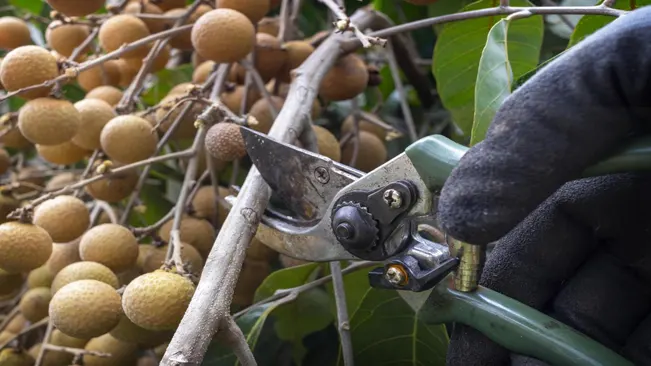
- Timing: The best time to prune is during late winter or early spring before the new growth starts. This timing helps the tree heal quickly and reduces the risk of disease.
- Removing Dead or Diseased Branches: Regularly inspect and remove any dead or diseased branches. This not only improves the tree’s appearance but also prevents the spread of diseases and pests.
- Thinning Dense Areas: Thinning out dense branches enhances air circulation and sunlight penetration to the inner parts of the tree. This is crucial for reducing disease risk and promoting better fruit production.
- Shaping the Tree: Pruning can be used to shape the tree, keeping it at a manageable size and making harvesting easier. However, be careful not to over-prune, as this can stress the tree and reduce fruiting.
Pest and Disease Management
Longan trees are susceptible to various pests and diseases, such as aphids, mites, and fungal infections. Regularly inspect the tree for signs of trouble and treat promptly with appropriate organic or chemical treatments.
Common Pests
- Aphids: These small, sap-sucking insects can cause leaf curling and can excrete a sticky substance called honeydew, leading to sooty mold. Controlling aphids can be done with insecticidal soaps or neem oil.
- Mites: Spider mites can cause leaf discoloration and drop. They thrive in dusty conditions, so keeping the area around the tree clean can help. Miticides or horticultural oils are often used for control.
- Mealybugs: These pests produce a waxy coating and can weaken the tree by sucking sap. They also excrete honeydew. Insecticidal soaps or oils can be effective against them.
- Scale Insects: Scale can damage longan trees by sucking on the sap, leading to poor growth. They are controlled with horticultural oils or systemic insecticides.
Common Diseases
- Fungal Infections (like Anthracnose): This causes dark, sunken lesions on fruits, leaves, and stems. Good air circulation, keeping foliage dry, and fungicidal sprays can manage anthracnose.
- Root Rot: Caused by overly wet soil conditions, root rot can be fatal. Ensuring proper drainage and avoiding overwatering are key preventive measures.
- Sooty Mold: This black mold grows on the honeydew excreted by aphids and mealybugs. Controlling the pest population is essential to prevent sooty mold.
Pest and Disease Management Strategies
- Regular Inspection: Frequent monitoring of your longan tree is essential to identify and manage pests and diseases early.
- Cultural Practices: Good gardening practices such as proper watering, pruning for air circulation, and keeping the area around the tree clean can prevent many problems.
- Organic Treatments: Options like neem oil, insecticidal soaps, and horticultural oils can effectively manage many pests without harming beneficial insects.
- Chemical Treatments: In cases of severe infestations or infections, chemical treatments may be necessary. It’s important to use these according to the manufacturer’s instructions and with consideration of environmental impact.
- Integrated Pest Management (IPM): This approach combines cultural, biological, and chemical means to manage pests and diseases in an environmentally and economically sustainable way.
Harvesting
Longan fruits typically ripen in late summer. The fruits are ready to harvest when they turn a light brown color, and the flesh inside is translucent. Gently twist the fruit off the stem or cut the entire fruit cluster from the tree.
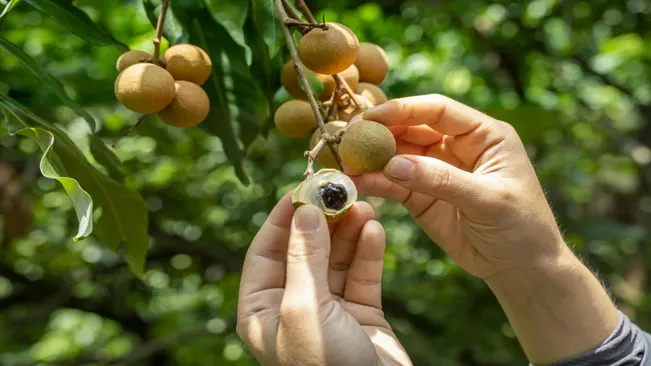
- Color Change: Mature longan fruits will turn from green to a light brown or tan color. This color change is the most reliable indicator of ripeness.
- Texture: The skin of the fruit becomes slightly rough to the touch.
- Translucency of Flesh: When gently squeezed, the fruit should feel slightly soft, indicating that the flesh inside has become translucent and juicy.
Harvesting Techniques
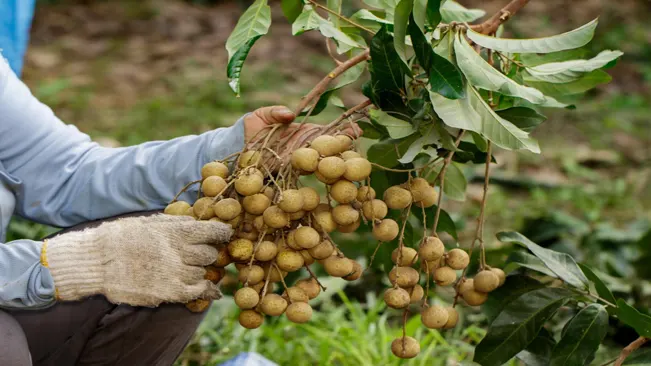
- Individual Fruit Harvesting: For small-scale gardens or personal consumption, longan fruits can be picked individually. Gently twist the fruit while holding the stem to detach it without damaging the tree.
- Cluster Harvesting: If you’re harvesting a larger quantity, it’s more efficient to cut the entire cluster. Use a sharp pair of gardening shears or scissors to cut the stem holding the cluster, being careful not to harm nearby fruit clusters or branches.
- Height Consideration: For trees that have grown tall, a ladder or a long-handled fruit picker might be necessary. Ensure safety measures are taken to prevent falls.
Post-Harvest Handling
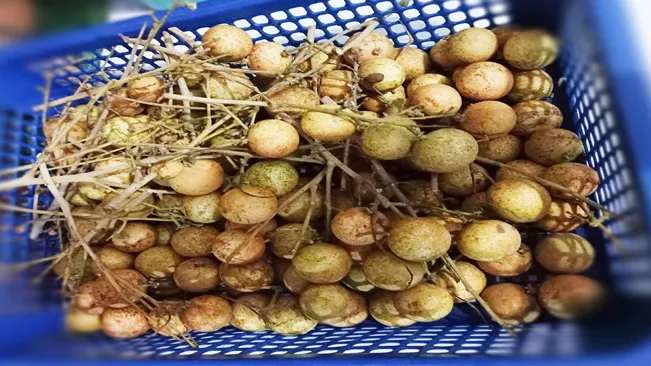
- Immediate Consumption: Longan fruits are best when eaten fresh, soon after harvesting. They offer a burst of sweetness and hydration.
- Storage: If you need to store them, keep the fruits in a cool, dry place. They can be refrigerated to extend their freshness for a few days.
- Preventing Bruising: Handle the fruits gently during and after harvest to prevent bruising, as bruised fruits deteriorate quickly.
Preservation Methods
- Drying: Longans can be dried for long-term storage. Dried longans, often called “dragon eyes,” are a delicacy and can be used in various culinary preparations.
- Freezing: You can also freeze the flesh of longan fruits. Peel and pit the fruits before freezing them in airtight containers.
Cultural Significance and Uses
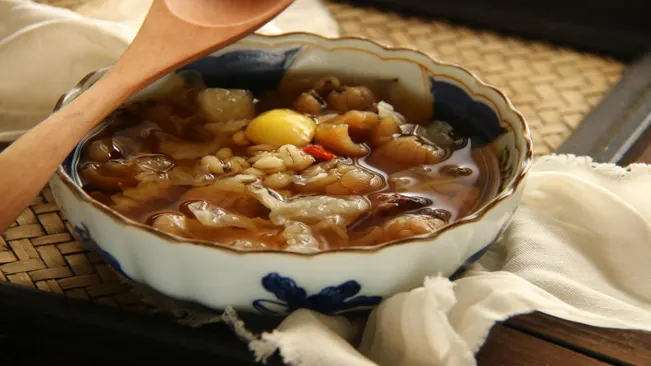
- Culinary Uses: In addition to eating fresh, longans are used in desserts, salads, and sometimes in savory dishes in Asian cuisine.
- Traditional Medicine: In traditional medicine, longan fruit is believed to have health benefits, like enhancing relaxation and aiding digestion.
Related Growing Guides:
Conclusion
Growing a longan tree can be a delightful and fruitful endeavor. With proper care, your longan tree will not only beautify your garden but also provide you with a delicious and exotic fruit. Remember that patience is key; it may take several years before a young tree bears fruit. Nonetheless, the wait is undoubtedly rewarding as you enjoy the fruits of your labor.
FAQs (Frequently Asked Questions)
- What climate is best for growing longan trees?
Longan trees thrive in a warm, tropical to subtropical climate. They are more tolerant of cooler temperatures than lychees but require protection from frost. - How much sunlight does a longan tree need?
Longan trees need full sun, at least six hours of direct sunlight daily, to grow well and produce fruit. - What type of soil is suitable for longan trees?
Well-draining soil is crucial, ideally sandy loam or loamy sand with a slightly acidic to neutral pH. - Can I grow a longan tree from seed?
Yes, but growing from seed can take longer to bear fruit and may not produce the same quality as the parent tree. Grafted saplings are usually preferred for more reliable fruit production. - How do I water my longan tree?
Young trees need consistent moisture. Water deeply once a week, allowing the soil to dry slightly between waterings. Reduce frequency as the tree matures but ensure sufficient water during the fruiting season. - When and how should I fertilize my longan tree?
Fertilize young trees every six to eight weeks with a balanced fertilizer. As trees mature, reduce to 2-3 times a year, particularly before and after the fruiting season. - Is pruning necessary for longan trees?
Yes, annual pruning to remove dead or diseased branches and to thin dense areas is necessary to maintain tree health and shape, and to promote good air circulation. - How do I protect my longan tree from pests and diseases?
Regularly inspect your tree for signs of pests or diseases. Treat promptly with appropriate organic or chemical treatments, following safety guidelines. - When is the right time to harvest longan fruits?
Longan fruits are typically ready for harvest in late summer when they turn light brown and the flesh inside is translucent. Gently twist the fruit or cut the entire cluster to harvest. - How long does it take for a longan tree to bear fruit?
Grafted longan trees can start bearing fruit in 3-4 years, whereas seed-grown trees may take longer, around 5-7 years.

Kristine Moore
Forestry AuthorI'm Kristine Moore, a seasoned garden landscaping professional with over 30 years of experience. My extensive career has been dedicated to transforming outdoor spaces into stunning, sustainable landscapes. With a deep understanding of horticulture, design principles, and environmental stewardship, I have become a respected figure in the field, known for creating harmonious, visually appealing, and eco-friendly gardens. My commitment to excellence and continuous learning in landscaping trends and techniques has solidified my reputation as an expert in garden design and implementation.







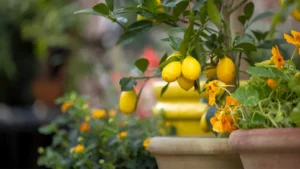
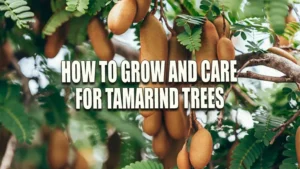



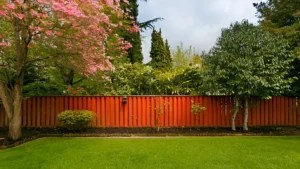
Miss Kristine. I'm interested to plan a Longan Tree. Where can l get a grafted longan tree to begin with? Thank you.
ZAMRI
April 4, 2024 2:08 pm